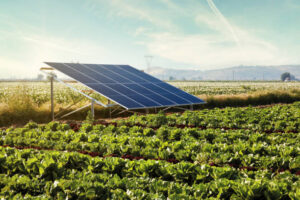
Introduction:
Agriculture has long been the backbone of India’s economy, providing livelihoods to a significant portion of the population. However, the sector faces numerous challenges, including water scarcity, land degradation, and the need for sustainable practices. In recent years, a novel approach known as agrivoltaics has emerged, offering a promising solution that combines agriculture with solar energy production. This integrated approach has the potential to revolutionize India’s agriculture sector by enhancing productivity, conserving resources, and promoting sustainable development.
Understanding Agrivoltaics:
Agrivoltaics, also known as solar farming, involves the simultaneous use of land for both agricultural activities and solar power generation. Traditional agriculture and solar panels coexist in a harmonious manner, maximizing the use of available land. This concept represents a paradigm shift in land use, providing an innovative solution to address the challenges faced by Indian farmers.
Land Optimization for Dual Use:
One of the primary advantages of agrivoltaics is the optimization of land use. In a country where arable land is a valuable resource, the ability to generate clean energy and grow crops on the same land is a significant breakthrough. Farmers can maintain their traditional agricultural practices while contributing to the production of renewable energy, creating a sustainable balance.
Enhancing Crop Yields:
Studies have shown that the shading effect from solar panels can positively impact crop growth. The moderation of temperature extremes and the reduction of water evaporation under solar panels create a microclimate that is conducive to certain crops. This can lead to increased yields and improved quality of agricultural produce, offering a win-win situation for both energy production and food security.
Diversification of Income Streams:
Agrivoltaics enables farmers to diversify their sources of income. By combining solar energy production with traditional agriculture, farmers can benefit from dual revenue streams. This diversification not only provides economic stability but also helps mitigate risks associated with the uncertainties of climate and market conditions.
Water Conservation:
Water scarcity is a significant challenge in many parts of India, impacting agricultural productivity. Agrivoltaics has the potential to contribute to water conservation by reducing evaporation from the soil. The shading effect from solar panels helps retain moisture, requiring less irrigation for crop growth. This water-saving aspect is particularly crucial in regions where water resources are under stress.
Energy Independence and Sustainability:
India, like many other countries, faces the challenge of meeting its growing energy demands while minimizing the environmental impact. Agrivoltaics can contribute to energy independence by harnessing solar power on-site. The clean energy generated reduces dependence on traditional energy sources, lowering carbon emissions and contributing to a more sustainable energy landscape.
Addressing Environmental Concerns:
The environmental benefits of agrivoltaics extend beyond reduced carbon emissions. The integration of solar panels into agricultural landscapes can help combat land degradation by providing a protective canopy over the soil. This protective layer shields the land from erosive forces, preserving soil fertility and preventing desertification.
Challenges and Considerations:
While agrivoltaics holds immense potential, it is not without challenges. The initial investment costs can be significant, and there is a need for careful planning to ensure that the shade from solar panels does not negatively impact the growth of certain crops. Additionally, there may be competition for land use, requiring effective policies and regulations to balance the interests of both agriculture and energy production.
Policy Support and Incentives:
The successful adoption of agrivoltaics in India requires supportive policies and incentives from the government. Financial incentives, subsidies, and regulatory frameworks can encourage farmers to embrace this innovative approach. A holistic policy approach that considers the specific needs and conditions of different regions can pave the way for widespread adoption.
Case Studies and Success Stories:
Highlighting successful case studies and real-world examples of agrivoltaics can provide inspiration and insights. Instances where farmers have successfully implemented solar panels alongside traditional crops, showcasing increased yields and economic benefits, can serve as models for others to follow.
Conclusion:
In conclusion, the integration of agriculture with solar panels has the potential to usher in a new era of sustainability and productivity for India’s agriculture sector. Agrivoltaics offers a unique solution to the challenges faced by farmers, providing a pathway to economic stability, resource conservation, and environmental sustainability. As the world grapples with the dual challenges of food security and clean energy, agrivoltaics stands as a beacon of hope, pointing towards a future where agriculture and renewable energy coexist harmoniously, shaping a resilient and sustainable landscape for generations to come.
